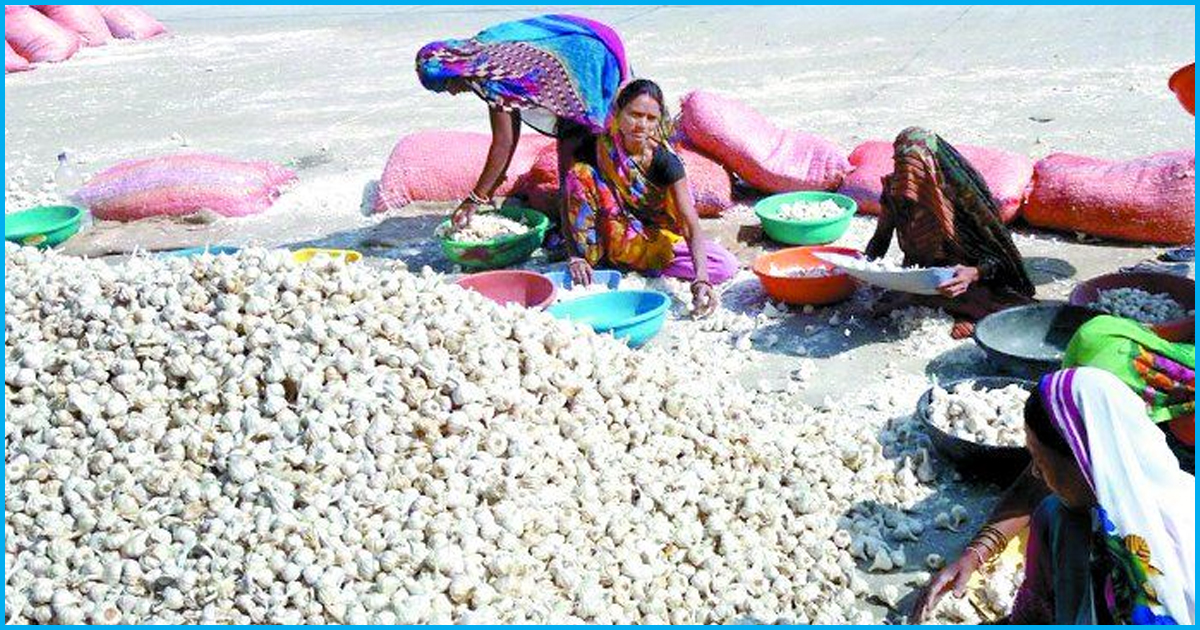
Farmers Discontent Rising As Garlic Prices Fall To Rs 1 Per Kg In MP
14 May 2018 12:23 PM GMT
Farmers in Malwa region of Madhya Pradesh opted to grow garlic this year, expecting higher returns after last year’s bumper crop of onions saw prices plummeting. However, with an increase in production, the price of garlic in state mandis has fallen to as low as Rs 1 per kg. The farmers are resentful as they are unable to recover the input costs, and many are choosing to throw away the produce as the cost of transporting it to mandis is more than the expected returns. Madhya Pradesh government’s much-lauded Bhavantar Bhugtan Yojna (Price Deficit Financing Scheme) seems unable to resolve the distress of farmers as many of them allege cartels have taken hold over the scheme.
Madhya Pradesh produces almost 30% of the country’s garlic. In January 2017, garlic prices per quintal in the state were in the range of Rs 6,000 – Rs 13,000. As reported by The Wire, in 2017-18, the area under garlic cultivation increased to 1.28 lakh hectares from 92,000 hectares in 2016-17. With increased cultivation, prices have been falling steadily and as of today, a quintal of garlic may fetch as low a price of Rs 260 i.e. Rs 2.6 per kg.
As reported by The Hindu, Suryabhan Singh Bana, a local farmer, said, “the garlic producing farmers are unable to recover their input costs and therefore, they prefer to throw it away than selling it at the prevailing low rates of ₹1 to ₹5 per kg.” He adds that since he could get only Rs 1-2 per kg of garlic, he has no other option but to throw it away.
Parts of Madhya Pradesh saw some scattered protests in March by garlic farmers. Rashtriya Kisan Mahasangh intends to hold a wider demonstration in the first week of June, in which supply of farm products like milk and vegetables to cities may be stopped. They have decided to include the plight of garlic farmers as one of their broader objectives, which also includes a demand for implementing Swaminathan Commission recommendations.
Inadequate Safety Net for Farmers
Bhuvantar Bhugtan Yojna was started in August 2017 as a safety net to protect farmers in case of major price fluctuations. The idea behind it is that the government doesn’t have to procure the produce, instead, money can directly reach the farmers via DBT. If implemented in an optimum manner, the scheme is economical for the government and better overall as it doesn’t distort the market prices.
Farmers are compensated if the trading price for their produce is less than the Minimum Support Price (MSP). So, if MSP for garlic is Rs 4,000 per quintal, and a farmer sold his produce for Rs 3,800 per quintal, the difference in amounts (MSP – Trading Price), Rs 200 per quintal will be transferred directly to the farmer’s bank account via DBT by the government. The problem, in this case, is the capping done by the government in the form of ‘modal price.’ The modal price is the average of the prices for which that particular crop was sold on any given day in Madhya Pradesh and in mandis of two other top states in terms of the volume of that crop produced.
A farmer selling the crop for a price less than or equal to the modal price will only be compensated for the amount difference in MSP and Modal price per quintal. Using the earlier example, if MSP of garlic is Rs 4000 per quintal, and Modal Price is Rs 3750 per quintal, a farmer selling the crop for Rs 3800 per quintal, will get Rs 200 per quintal. In case a farmer sells his produce for Rs 3600 per quintal, s/he shall only be entitled to receive Rs 250 per quintal (MSP – Modal Price). Many farmers were caught unawares by this fine print and are now facing a subsistence crisis.
This scheme, on one hand, is being praised by the central government and also being pushed by the NITI Aayog, while on the other hand the farmers and cultivators are complaining about several shortcomings including delays and alleged cartelisation by traders. The traders keep the prices depressed during the scheme period by paying farmers a lower price and asking them to approach the government for the rest.
The Way Ahead
If production is less, the farmers suffer. If there is a bumper crop, the farmers still suffer. Last year, onion prices collapsed so farmers switched to garlic cultivation, but the trend is repeating itself. Loan waivers provide temporary relief to indebted farmers but it is an inefficient use of public money as it doesn’t address the flaws in the system. A lack of market linkages leaves the farmers with very little bargaining power and totally at the mercy of traders.
Proper implementation of a price deficiency payment scheme like BBY is needed to ensure farmers are protected from market volatility along with seamlessly integrated market with spot, future and forward trading and storage and quality certification support.
 All section
All section













